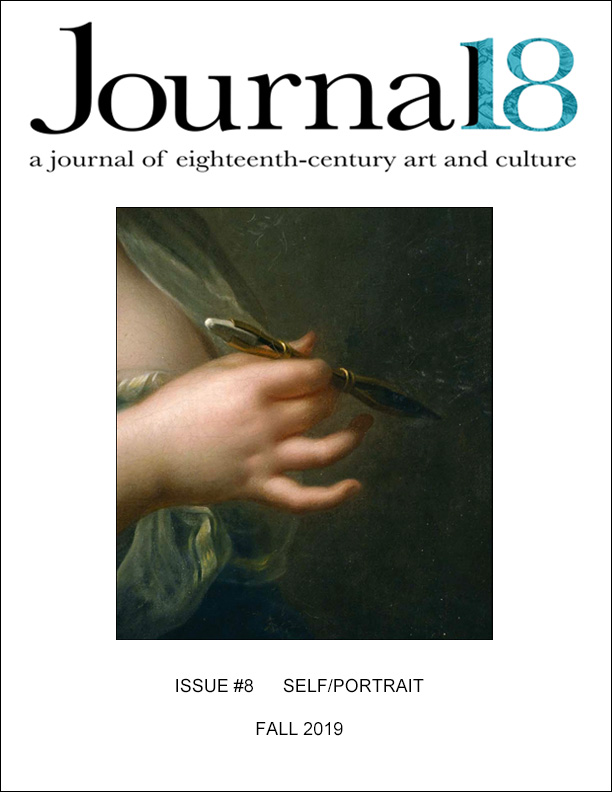
Enlightenment philosophies have defined modern conceptions of the self and individual. Not coincidentally, the eighteenth century was also a period in which representations of the self took on a new prominence in artistic practice, becoming sites of innovation and experimentation in a range of visual and material forms. Self-representation emerged as a crucial space for navigating the individual’s place in society, for pushing the boundaries of artistic convention, and for exploring conceptions of mind, body, and identity. As institutional restrictions on art were challenged, as new movements and political shifts redefined who and what the artist was, and as an emphasis on introspection and subjectivity emerged, the eighteenth century witnessed new kinds of artistic engagement with the self.
Mindful of these developments, this issue of Journal18 is concerned with expanded notions of both the “self” and the “portrait,” rather than with “self-portraits” per se. How was art used to explore the self? Beyond mere self-fashioning, how did eighteenth-century artists use portraits (in whatever form) to interrogate, examine, relate, express, and communicate? And beyond conventional self-portraiture, how did artists inscribe themselves into their works? The articles in this issue explore self/portrayal through an array of unexpected forms, from Tracy Ehrlich’s study of an architect’s delightful interventions of self in technical drawings, to Kerstin Maria Pahl’s investigation of words-in-images and writing as a self-referential mark. The self is also found in different spaces—from Joséphine’s garden at Malmaison, in Susan Taylor-Leduc’s article; to Hubert Robert’s prison cell, in Frédérique Baumgartner’s—and it is found in the singular and in the plural, as Séverine Sofio discovers with Gabrielle Capet’s “collective” self-portrait.
In addition to the main articles, this issue also features a “Gallery” of shorter vignettes devoted to particular instances of engagement with self and portrayal. Susan M. Wager examines Madame de Pompadour’s curatorial decisions at Versailles as self-defining acts; while Paris A. Spies-Gans looks at how portraiture became a tool for a still life painter in Mary Moser’s explorations of artistic identity. Yuriko Jackall investigates authorship and intellectual property through a notorious case of alleged plagiarism between Greuze and a former student; and Andrea Morgan examines the social role of the artist’s image through portraits exchanged between Kneller and his engraver. Taking us beyond traditional definitions of “self” and “portraiture,” together the contributions to this issue deepen our understanding of the modes and imperatives of self-expression, self-perception, and self-representation in the long eighteenth century.
Issue Editors
Melissa Hyde, University of Florida
Hannah Williams, Queen Mary University of London
ARTICLES
Carlo Marchionni, Architetto Romano: Drawing the Self in Eighteenth-Century Rome
Tracy Ehrlich
Autographing the Self: Self-Portrayal through Lettering in Eighteenth-Century England
Kerstin Maria Pahl
Hubert Robert in Prison: Self, Revolution, and the Contingencies of Artistic Inscription
Frédérique Baumgartner
Gabrielle Capet’s Collective Self-Portrait: Women and Artistic Legacy in Post-Revolutionary France
Séverine Sofio
Joséphine at Malmaison: Acclimatizing Self and Other in the Garden
Susan Taylor-Leduc
“GALLERY”
The Fast and the Fugitive: Pompadour’s Curatorial Self/Portrait at Versailles
Susan M. Wager
Mary Moser: Portraitist
Paris Spies Gans
Off with Greuze’s Heads: A Case of Identity Theft
Yuriko Jackall
Self/Portraiture and Artistic Exchange: John Smith and Sir Godfrey Kneller in Early Modern England
Andrea Morgan
Cover image: Detail of Marie-Gabrielle Capet, Self-Portrait, c. 1783. Oil on canvas, 77.5 × 59.5 cm. Museum of Western Art, Tokyo. Image source: Wikimedia Commons. Image in the public domain.
